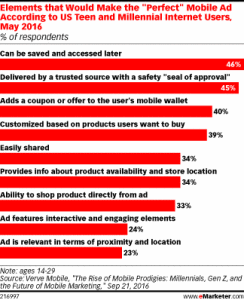ARE BUY BUTTONS ON SOCIAL MEDIA A GOOD IDEA?
Marketers are very excited by social media buy buttons, but consumers? Not so much. This survey of user habits on social media is a useful reminder that just because an idea looks good on a marketing plan doesn’t mean it’s something that serves our customers well.
#social #media #adtech
DATA REVEALS SURPRISING, UNCOMFORTABLE TRUTH
According to Spotify, the number one zip code for playing Justin Bieber’s “Sorry” is Williamsburg, Brooklyn.
#data
HUBSPOT ON THE BENEFITS OF NATIVE ADVERTISING
This HubSpot article on the benefits of native advertising is well-argued and cites a wealth of links to relevant studies. Of interest:
—Consumers look at native ads 52% more frequently than banner ads:.
—Native ads receive two times more visual focus than banners:
—Native CTR performance can be 85% higher than banner ads. n.b. This data point is from a Stackadapt study that uses an “average” banner CTR of .06%. Since Verso’s average is more like .1%, the percentage improvement is not as high for our campaigns, but it’s still significant.
—Avg CTR for banner ads is .08%. n.b. This links to a useful tool from Google for identifying benchmark rates, that identifies the average click-through rate as .08% (.05% for Flash, in case anyone’s still using that format!). It’s important to keep saying this: we expect—and see—better average CTRs for Verso campaigns.
#native advertising #data
DIGITAL ADS ARE GETTING SMARTER. ARE ADVERTISERS?
A professor at the University of Chicago looks into advertising spend on search, email and mobile. Among his surprising discoveries: most sales do not result from users who click on ads:
“In fact, 78 percent of the increase in sales in the Yahoo experiment was from users who never clicked on the ads. ‘Even though clicks are a standard measure of performance in online-advertising campaigns, we find that focusing only on clickers leads to a serious underestimate of the campaign’s effects.’”
#research #search #email #clickthroughs
OLDER USERS RESPOND BETTER TO DIGITAL
Two former Yahoo researchers show that the effect of online advertising on sales increases with age, with the top performing group over 65. So maybe book publishers shouldn’t worry about Snapchat so much right now.
#research #sales
CREATIVE PERSISTENCE
A report from professors at the University of Chicago’s Booth Business School and Northwestern’s Kellogg School of Management details the importance of persistence when it comes to creative breakthroughs.
#creative
NEW LUMA REPORT
Here’s LUMA’s new report on the state-of-the-art of digital marketing. The number one new trend is mass-personalization across channels. This of course requires very smart “identity” data. Slide 31 points to developments on this score. The second largest trend, content marketing, requires traditionally siloed departments such as advertising, PR, web development and email to work in concert. (Via BusinessInsider)
#adtech
IS THE VINE EXPERIMENT OVER?
Two years ago it was one of the hottest new marketing platforms, but AdWeek reports that today Vine accounts for just 6% of video marketing using advertiser-produced video (compared to 64% YouTube and 24% Facebook). That said, it’s still a viable platform if you use it right and partner with social media stars:
“Vine still shines when social stars are involved. Instead of brands posting their own content, Burns said that clients are looking to team up with top influencers who have amassed massive followings to create sponsored content.”
#social #video #vine
MOST MOBILE AND DESKTOP VIDEO ADS SERVED AGAINST SHORT FORM
Emarketer reports: “Q3 2015 research from FreeWheel found that 69% of digital video ad views served by its platform to smartphones occurred while users watched content shorter than 20 minutes.” Perhaps more surprising was the revelation that desktop video watching is still twice that on mobile and tablets:
“In 2015, US adults will spend an average of 12 minutes per day watching digital video on their smartphones and an average of 14 minutes on their tablets. Time spent on desktop and laptop is higher, with US adults spending an average of 24 minutes per day watching digital video.”
#video
AGAINST BAD ADS
And by “bad,” we mean a bad experience for the user. As this NYT article says, there are far too many digital ads right now that try to work up the engagement numbers through forcing you to click on the content when you were just trying to get the ad out of your face. It’s a little ironic (but only a little), since the NY Times website is not immune to these kind of ads (this cat owner is looking at you, Purina dog chow video). But this might be the kind of culture we create when every marketing job is numbers based—judging a campaign by how many people clicked on the ad, rather than to how many people responded to what you were advertising.
#creative







